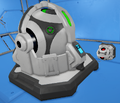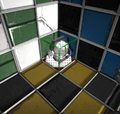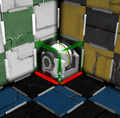Gyroscope
| Gyroscope | |
|---|---|
| Category: | Mobility |
| Function: | provides rotation to ships |
| Fits small grid | |
| Mass: | 613.6 kg |
| Power: | 0.002 MW |
| Force: | 448000 N |
| PCU: | 50 |
| Size: | 1x1x1 |
| Time to Build: | 14 sec |
| Fits large grid | |
| Mass: | 12817.0 kg |
| Power: | 0.01 MW |
| Force: | 33600000 N |
| PCU: | 50 |
| Size: | 1x1x1 |
| Time to Build: | 40 sec |
| Data Controls: | [edit] [purge] (?) |
Adding ![]() Gyroscopes to a mobile grid enables the player to control a vessel's orientation (rotation). The rotation is called pitch, roll, or yaw.
Gyroscopes add the ability to control the grid’s pitch and yaw by:
Gyroscopes to a mobile grid enables the player to control a vessel's orientation (rotation). The rotation is called pitch, roll, or yaw.
Gyroscopes add the ability to control the grid’s pitch and yaw by:
- by moving the mouse,
- by pressing the arrow keys and Q key and E key to roll,
- by moving the 'sticks on a controller.
The rotation is centered on the Center of Mass. Consider that, since Gyroscopes are heavy, adding gyroscopes also shifts the centre of mass.
Usage
Gyroscopes let you rotate and stabilise your ship (or rover, or walker), keeping it stable even when no one is manning the cockpit.
If you have the capacity to build several gyroscopes on a vehicle without it being too heavy for its size, you can configure them differently. Some examples:
- On one or more gyroscopes, keep the override switched off, and use them to turn the vehicle manually with mouse/keyboard/controller.
- On one additional gyroscope, switch the override on, and leave all RPM sliders at 0, which provides constant automatic stabilisation.
- For a rover, switch an extra gyroscope off and give it a low override on the “roll” axis. When ever the rover lands on its roof, switch this overridden gyroscope on for a few seconds to force the rover to roll back onto its wheels.
How to turn
Gyroscopes let the pilot to rotate around three axes. a grid’s pitch, yaw, and roll.
- When steering a rover, gyroscopes let you turn left/right, and correct roll/pitch when you catch air, with the mouse.
- The AI Flight and Autopilot functionality requires Gyroscopes.
- A Drop Pod or damaged ship that lacks thrust in some directions also lacks automatic Inertial Dampers. Careful manual gyroscope rotation allows a skilled pilot to apply the remaining thrust in the desired direction.
| Yaw | Pitch | Roll |
|---|---|---|
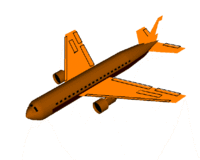
|
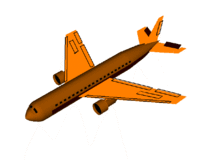
|
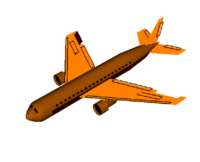
|
How to stablize a vehicle using Overrides
An overridden gyroscope will force the whole vehicle to spin around the chosen axis (centered on the center of mass), which is useful to right vehicles that have flipped over. Or if set to zero, respectively, prevent the whole vehicle from tilting (gyro lock), which is used for stabilization.
Typical usecases for Gyroscope Overrides are:
- automatically stabilising rovers and racecars (constant braking torque)
- stabilizing walkers (constant braking torque)
- stopping a spaceship from spinning after a collision with an asteroid (constant braking torque)
- rotating a flipped vehicle once (temporary rotational torque)
- spinning a space station continuously (constant rotational torque)
In the Control Panel Screen under Override Controls, you can create a constant rotating or braking torque along an axis (pitch, yaw, or roll) of the gyroscope. Such an overridden gyroscope will force (or prevent) the vehicle to spin around the chosen axis, centered on the center of mass.
- By default, Override Controls is switched off. This means the pilot can use this gyro to control the vehicle’s rotation through the mouse and keyboard.
- If Override Controls is switched on, and RPM is set to zero, the Gyroscope applies a constant stabilising braking torque on that axis (gyro lock).
- If Override Controls is switched on, and RPM is set to a non-zero value between +30 and -30 RPM, the Gyroscope applies constant rotational torque.
You can tell from the outside which gyroscopes are on override because they shine blue. It’s important to know for the pilot how many gyroscopes are on override, because overridden Gyroscopes are no longer available for mouse control.
The amount of the RPM value (rotations per minute) determines whether the gyroscope spins violently or gently. Increase the override values slowly, because sudden powerful overrides, or rather the resulting sudden spin, will slam the vehicle against the ground and damage it.
How to balance speed and mass
The more mass a ship has, the more Gyroscopes are needed to achieve the same amount of turning sensitivity.
The gyroscopes' effectiveness is proportional to the number of working gyroscopes onboard, and inversely proportional to the vessel's mass. This means that constructing additional gyroscopes on a vessel will make it yaw, pitch, and roll quicker. However, when you increase the mass which the gyroscopes will have to move (by adding gyroscopes, thrusters, machinery, structural armour, etc.), the ship's responsiveness will decrease again.
On the Control Panel Screen under Power, you can adjust the rotational sensitivity of a gyro from 100% to 0% (off). Well tuned gyroscope settings allow for very small ships to react to input with precise turning, rather than violent, jerky spinning.
Troubleshooting
For Gyro axis configuration to be user-friendly in the Control Panel Screen, it is recommended to build all Gyroscopes facing the same way, so their axes end up being labelled the same. Sometimes your ship interior forces you to build them in different orientations. Then remember you can't select them all and apply the same override settings. Label and group them and then find the right axis for each group.
Be aware that, if you set two gyroscopes' overrides along the same axis to opposing values (for example, one gyro to +10 RPM yaw and the other -10 RPM yaw), they cancel each other out and nothing will happen and you don't see why. You can get into this situation accidentally if one of the gyroscopes faces the other way round, so if two overrides together don't do anything, try them separately.
Gyroscopes on a zero-RPM override don’t keep the ship/rover level. They just resist rotation wherever it is. If you are already tipped over, overrides will prevent you from turning right side up, so switch them off then.
Having too many Gyroscopes can make a ship twitchy and difficult to turn, as they increase the control sensitivity due to the increased turning power. This effect can be mitigated by either reducing the number of Gyroscopes installed, or by adjusting the Gyroscopes' sensitivity in their control panels.
Power Usage
Gyroscopes use only a tiny amount of power, regardless of whether the ship is at rest or being made to roll. The large ship version uses approximately 30 W at full power, while the small ship version uses only 0.6 W - 1/50th the power. It is difficult to estimate the exact figures, due to reliance upon power usage outputs while piloting the ship.
Gallery
Construction
If progression is on and you don't see Gyroscopes in your G-menu, build any cockpit first to unlock it.
Gyroscopes need power to function and are very heavy. When placing them, a space engineer needs to find an effective balance between mass and turning speed for each ship.
A Gyroscope takes up a 1x1x1 block space on both small and large ships. It has mount points only on its bottom face. This means that gyroscopes are relatively vulnerable to breaking off when their one mounted blocks gets destroyed, which may suddenly rob a ship of its manoeuvrability.
Large-grid gyroscopes feature a control panel on their front side; Small-grid gyroscopes lack this control panel, and they are also too small to carry a Control Panel, so their settings can only be accessed from a cockpit's or Remote Control's Control Panel Screen.
The front of the gyroscope (for large grid, where the control panel is) determines where which rotational axis will be, not the cockpit orientation. If you place it "the wrong way round", it will still work, but the axes will seem mislabelled. Gyroscope Overrides are easier to configure if you place the gyroscope to face the same way as the cockpit.
Does placement matter? Similar to thrusters, gyroscopes apply their effect to the Center of Mass, no matter where on the grid you place them. At the same time, due to their high mass, the act of placing them invariably shifts the Center of Mass and the point around which they rotate. Rotation feels more intuitive when the center of mass is where the pilot perceives the center of the ship to be, or where the cockpit is. So keep an eye on the Center of Mass while placing your gyroscopes and make sure it ends up where you expect it to be, and not shifted off to one side.
Tip: To see where your center of mass is, open the Info Screen and enable Show Center of Mass while building.
Recipe
| Component | Large Ship/Station Required | Large Ship/Station Optional | Small Ship Required | Small Ship Optional |
|---|---|---|---|---|
| 500 | 100 | 15 | 10 | |
| 4 | — | 2 | — | |
| 50 | — | — | — | |
| 4 | — | 1 | — | |
| 40 | — | 5 | — | |
| 5 | — | 3 | — | |

